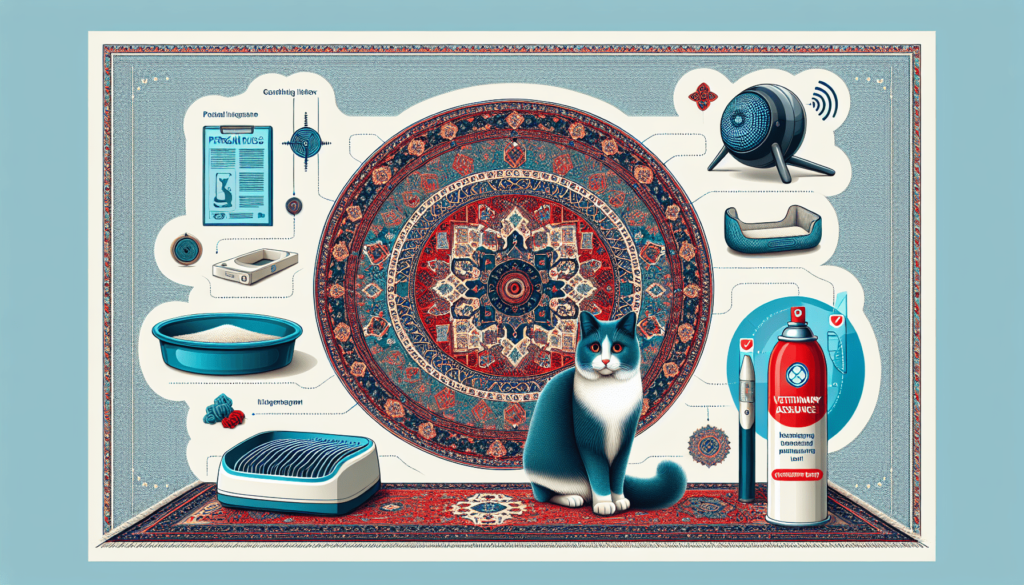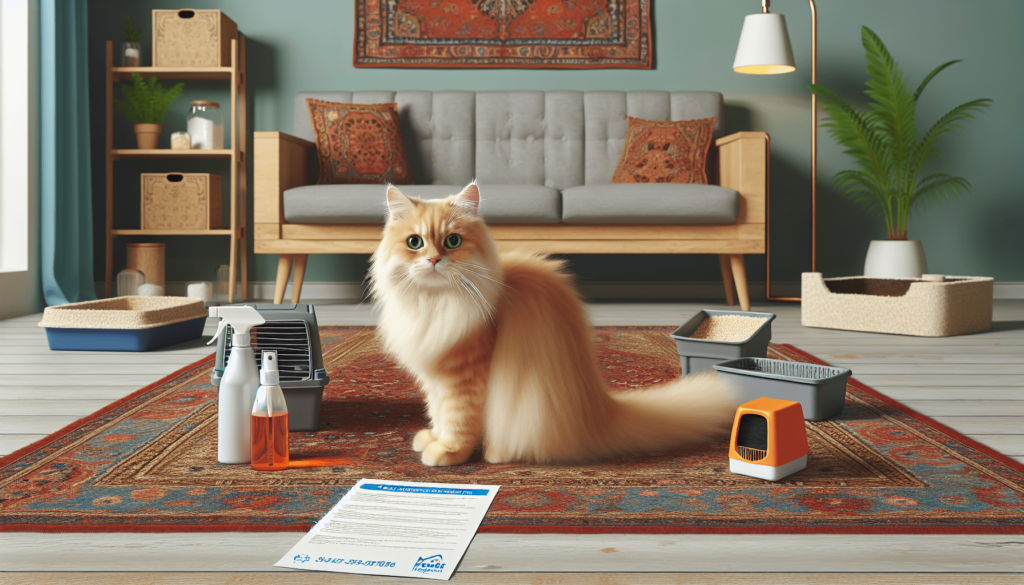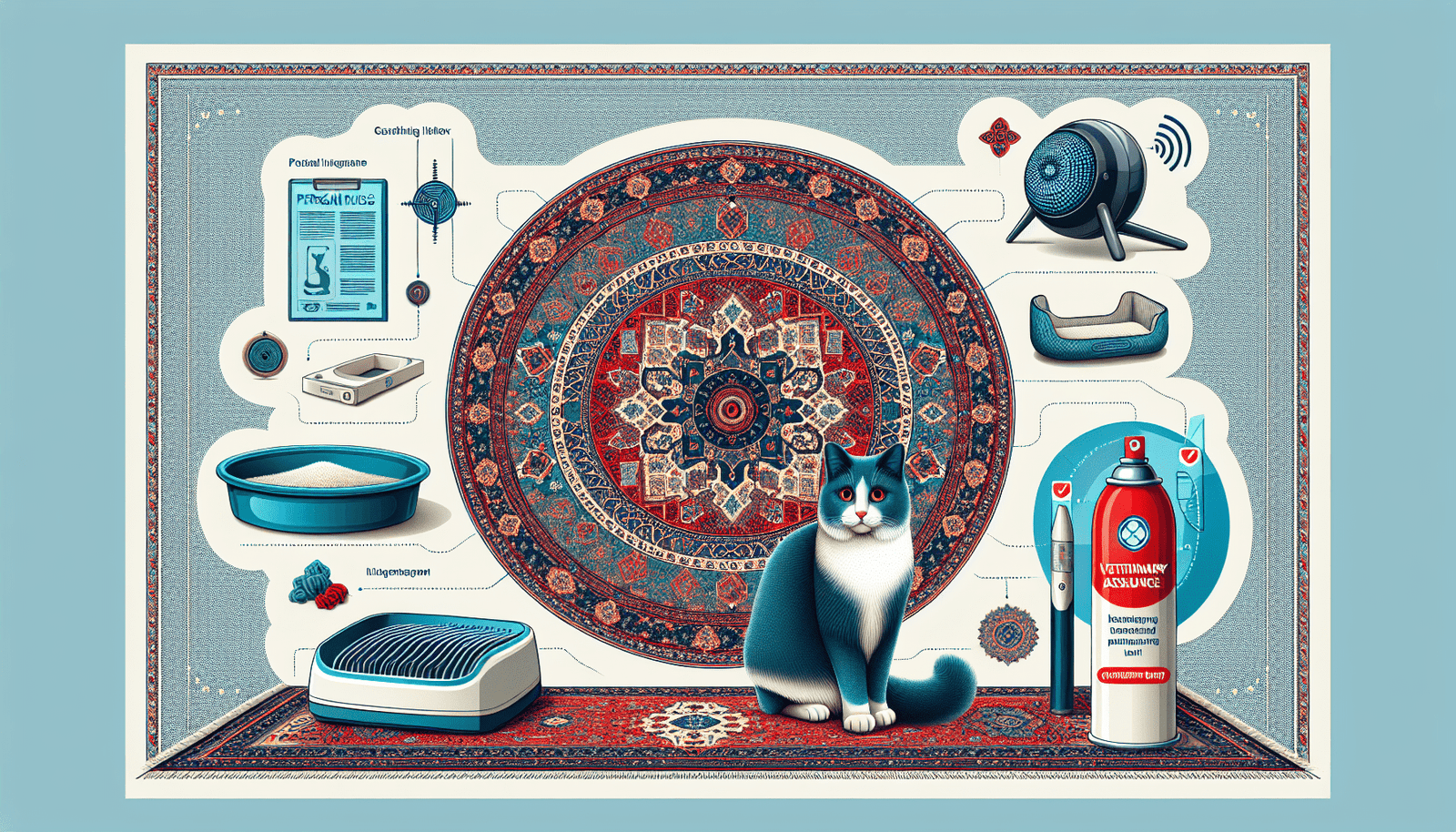If you’re a proud owner of a Persian rug and a mischievous cat, you know the struggle of finding your beloved rug soaking wet from time to time. Not only can this be frustrating, but it can also damage your precious rug. Fear not, for there are effective ways to stop your feline friend from using it as their personal bathroom. In this article, we’ll explore some creative and practical solutions that will help you maintain the integrity of your stunning Persian rug while keeping your furry companion happy and content.

Identify the Root Cause
If your cat is repeatedly peeing on your Persian rug, it is important to first identify the root cause of this behavior. There are two main aspects to consider – medical issues and behavioral triggers.
Check for any medical issues
It’s essential to rule out any underlying medical issues causing your cat to urinate outside the litter box. Schedule a visit to the veterinarian to ensure your cat is in good health. The vet will perform a thorough examination and may recommend further tests, such as a urinalysis, to rule out any urinary tract infections or other medical conditions that could be contributing to the inappropriate urination. By addressing any medical issues, you can effectively treat the behaviors associated with them.
Look for behavioral triggers
While medical issues may be the root cause of your cat’s behavior, it is also important to consider any behavioral triggers that may be causing your cat to avoid the litter box. Stress, anxiety, and changes in the household can all impact your cat’s behavior. Stressors may include new pets, moving to a new home, or changes in the family dynamics. By identifying the underlying triggers, you can take steps to provide a more conducive and stress-free environment for your cat.
Provide a Suitable Litter Box
A suitable litter box is vital in encouraging your cat to use it instead of your prized Persian rug. Consider the following aspects to ensure an ideal litter box setup:
Choose the right type of litter box
Cats have their preferences when it comes to litter box design. Some cats prefer covered litter boxes for privacy, while others may prefer open ones. Provide various options to see which type your cat prefers. Additionally, ensure the litter box is large enough for your cat to comfortably move around and turn in.
Ensure cleanliness of the litter box
Cats are meticulous creatures, and a dirty litter box can discourage them from using it. Scoop the litter box daily to remove waste and clumps. Regularly change the litter to keep it fresh. Consider using unscented litter as some cats may find strong scents off-putting.
Offer multiple litter box options
If you have multiple cats in your household, it is essential to provide enough litter boxes to avoid territorial issues. The general rule of thumb is to have one litter box per cat, plus an extra. This ensures that each cat has sufficient access to a clean litter box whenever they need it.
Manage Stress and Anxiety
Stress and anxiety can contribute to a cat’s urination outside the litter box. By creating a calm and safe environment, you can help alleviate these issues and discourage your cat from soiling your Persian rug.
Create a calm environment
Provide a tranquil space for your cat to relax. This can include a cozy bed, a designated cat tree, or a quiet room where they can retreat to when they need some alone time. Minimize loud noises, rearrange furniture gradually, and avoid sudden changes to establish a sense of security for your feline friend.
Provide hiding places
Cats often like to have hiding spots where they can retreat when they feel overwhelmed or anxious. Place cat beds, blankets, or even cardboard boxes in various locations around your home to provide safe hiding spots for your cat. These areas will help to reduce stress and promote a sense of security.
Use pheromone sprays or diffusers
Pheromone sprays or diffusers, such as those containing synthetic feline facial pheromones, can help create a soothing environment. These products mimic the natural pheromones secreted by cats, which promote feelings of security and reduce stress. Using them in the area where your cat spends most of their time can help ease any anxiety that may be contributing to their inappropriate urination behavior.
Establish a Routine
Cats thrive on routine and structure. By establishing a consistent daily routine, you can help prevent inappropriate urination on your precious Persian rug.
Set a consistent feeding schedule
Feed your cat at the same time each day to create a regular routine. This not only helps with their general well-being but also ensures they have consistent bowel movements, reducing the likelihood of accidents outside the litter box.
Ensure regular play and exercise
Provide your cat with regular play sessions and opportunities for exercise. Engaging in play not only provides mental stimulation but also helps reduce stress and anxiety. Use interactive toys, laser pointers, or puzzle feeders to keep your cat entertained and active.
Maintain a consistent routine for litter box cleaning
Consistently maintain the cleanliness of the litter box by scooping it daily and changing the litter as needed. Cats appreciate a clean and fresh litter box, and by providing this, you are encouraging your cat to use the appropriate spot rather than your Persian rug.

Use Positive Reinforcement
Positive reinforcement is a powerful tool in training your cat to use the litter box consistently. By rewarding desired behavior, you can help shape their actions and encourage them to avoid peeing on your rug.
Reward desired behavior
When your cat uses the litter box correctly, provide them with immediate praise and rewards. This can include verbal praise, treats, or their favorite toys. By associating positive experiences with proper litter box use, your cat will be more inclined to repeat the behavior.
Avoid punishments
Punishments, such as yelling or physical discipline, are not effective in preventing inappropriate urination and can actually increase your cat’s stress levels. Instead, focus on positive reinforcement and redirection techniques to encourage the desired behavior.
Consider clicker training
Clicker training is a positive reinforcement technique that can be used to train cats. By associating a clicking sound with a reward, you can effectively communicate with your cat and reinforce the behavior you desire. Clicker training can be used to train your cat to use the litter box consistently, further reducing the chance of accidents on your Persian rug.
Clean the Rug Thoroughly
To prevent your cat from returning to the same spot on your rug, it is crucial to thoroughly clean it and eliminate any lingering urine scent.
Use enzymatic cleaners
Enzymatic cleaners are specifically designed to break down the organic compounds found in urine. Regular household cleaners may mask the scent to our noses but not to a cat’s sensitive sense of smell. Apply the enzymatic cleaner according to the product instructions, ensuring you saturate the affected area. This will neutralize the odor and discourage your cat from revisiting the spot.
Avoid ammonia-based cleaners
Ammonia has a similar scent to urine and may actually attract your cat back to the area. Avoid using ammonia-based cleaners, as they can create confusion for your cat and make it more challenging to deter them from urinating on the rug.
Eliminate urine scent completely
In addition to using enzymatic cleaners, consider steam cleaning the rug to penetrate deep into the fibers and remove any residual scent. This will help remove any remaining traces of urine and make the rug less tempting for your cat to revisit.
Block Access to the Rug
Preventing your cat from accessing the rug altogether can be an effective solution, especially during the retraining process.
Close off the affected area
If possible, close the door to the room where the rug is located. By restricting access to the area, you minimize the chances of your cat urinating on the rug. Keep the door closed until your cat has consistently used the litter box for an extended period.
Use barriers or deterrence methods
If closing off the room is not an option, use physical barriers or deterrents to prevent your cat from reaching the rug. This can include placing baby gates or temporary fencing to create an obstacle. Alternatively, you can use harmless deterrents, such as aluminum foil, double-sided tape, or citrus-scented items, as most cats dislike these textures and scents.
Redirect the cat’s attention
To divert your cat’s attention from the rug, provide alternative and enticing options. Place scratching posts, interactive toys, or window perches near the litter box or in the areas where your cat tends to urinate. By creating attractive alternatives, you increase the chances of your cat using the appropriate areas and leaving your rug untouched.
Consult with a Veterinarian or Behaviorist
If your cat’s inappropriate urination persists despite your best efforts, it is essential to seek professional advice from a veterinarian or a certified animal behaviorist.
Seek professional advice
A veterinarian or behaviorist can conduct a comprehensive evaluation of your cat’s health and behavior to identify any underlying issues. They can provide tailored guidance and strategies to address the inappropriate urination specifically for your cat’s individual situation.
Consider medication if necessary
In some cases, medication may be recommended by a veterinarian to help manage your cat’s stress, anxiety, or other underlying medical conditions. Medication, when used in conjunction with behavior modification techniques, can be beneficial in resolving inappropriate urination issues.
Address any underlying issues
A professional’s expertise can help identify and address any underlying issues contributing to your cat’s urination problem. They can provide guidance on managing stressors, creating suitable environmental changes, and implementing effective behavior modification plans tailored to your cat’s unique needs.
Cat-Proof the House
Cat-proofing your house can prevent your cat from accessing inappropriate areas and reduce the chances of them urinating on your Persian rug.
Remove attractive alternatives
Identify any areas in your home where your cat may be tempted to urinate other than the litter box. This can include piles of laundry, rugs in other rooms, or any other soft surfaces that resemble a suitable spot for elimination. By removing these alternatives, you steer your cat towards using the litter box consistently.
Secure electrical cords and houseplants
Cats are known for their curiosity, and electrical cords and houseplants can be enticing objects to play with or chew on. Safely secure cords out of your cat’s reach and consider placing houseplants in hanging baskets or using plant stands to prevent access. This not only protects your cat from potential hazards but also helps create a safe and comfortable environment.
Provide appropriate scratching posts
Cats have a natural instinct to scratch, and providing suitable scratching posts can save your rug from being a target. Place scratching posts near your cat’s favorite locations and ensure they are sturdy and tall enough for your cat to stretch fully. Encouraging this natural behavior will help redirect your cat’s focus and minimize the chances of unwanted urination on your rug.
Monitor and Observe the Cat
Regular monitoring and observation of your cat’s behavior are key to understanding their patterns and identifying potential triggers for their inappropriate urination.
Watch for signs of urination
Keep a close eye on your cat to catch any signs of them urinating outside the litter box. If you witness this behavior, gently interrupt them and immediately redirect them to the litter box. By catching these instances early and promptly intervening, you can help reinforce the appropriate behavior.
Identify potential triggers
Pay attention to any environmental factors or situations that may trigger your cat to urinate on your rug. This can include loud noises, unfamiliar visitors, or changes in routines. By identifying these triggers, you can work on minimizing their impact and better manage your cat’s behavior.
Keep a record of incidents
Maintaining a record of each incident can help you identify patterns and potential solutions. Note the date, time, location, and any surrounding circumstances of each incident. This information can be invaluable in troubleshooting the underlying causes and working with professionals, should you decide to seek further guidance.
In conclusion, stopping a cat from peeing on your Persian rug requires a comprehensive approach. By identifying the root cause, providing a suitable litter box, managing stress and anxiety, establishing a routine, using positive reinforcement, thoroughly cleaning the rug, blocking access, consulting with professionals, cat-proofing the house, and monitoring your cat’s behavior, you can effectively address this unwanted behavior. Remember to approach the process with patience, understanding, and love as you work together with your cat to find a solution that benefits both of you.

